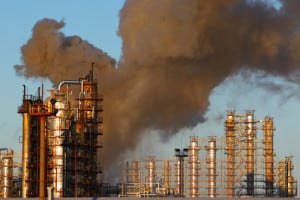
At gas plants and refineries, industrial safety is critical. Marathon Oil used gas sensors, wireless networks, and a location system to ensure safety.
Name of Organization: Marathon Petroleum Company
Industry: Energy
Location: Findlay, Ohio, USA
Business Opportunity or Challenge:
Industrial safety is crucial at refineries and natural gas plants, which are inherently hazardous environments. One of the deadliest refinery accidents in recent U.S. history occurred in 2005 at the Texas City Refinery, when heavy hydrocarbon vapors ignited, killing 15 workers.
While employees are well-trained in safety protocols and sophisticated equipment is in place to alert them to potential leaks or systems issues, it still takes time for plant operators to be alerted to problems, and for employees to be safely removed from problem areas. In October, an explosion at a Louisiana gas plant killed three people. On Dec. 2, a massive explosion occurred at the Ramsey Natural Gas Processing Plant in Texas, injuring two people and forcing the evacuation of 300 people within a 10-mile radius.
While these latest industrial safety incidents are under investigation, there’s a gap in the ability of industry to protect employees from hazardous gas exposure, a report from Accenture, posted by the Industrial Internet Consortium, observes. Today’s IoT devices can sense abnormally high gas levels in the air, and set off a series of alarms and flashing lights. However, these alarms only alert individuals locally, the report states.
“Standard safety procedures require the alarmed individual to immediately leave the area and report the incident. In some cases, however, individuals are unable to leave the area or report the alarm. This situation limits the ability to continuously improve the safety of the facility and jeopardizes both individual personal safety and the safety of the entire plant workforce.”
How This Business Opportunity or Challenge Was Met:
To provide a real-time approach to such issues, Marathon Petroleum Company teamed with Accenture to develop the Accenture Life Safety Solution—a wireless multi-gas detection system that helps protect workers in potentially hazardous environments. The solution combines Wi-Fi and location-based technologies with gas sensors to allow companies to remotely monitor incidents in locations previously not suited for wireless networks.

The Ventis LS mult-gas detector from Industrial Scientific is part of the Accenture Life Safety solution.
The solution – a set of services, technologies and processes — was developed by Accenture, in conjunction with AeroScout, which manufactures a real-time location system; Cisco; and Industrial Scientific, which makes gas-detection sensors.
“Employees wear a single, multi-gas detector (within 10 inches of their breathing zone) that is able to detect multiple gases,” Accenture states. “If abnormal levels of gas are detected, similar to traditional solutions, the device immediately alerts the employee. It also simultaneously transmits the gas-level information and personnel location over a wireless infrastructure using an integrated Wi-Fi tag located in the Industrial Scientific device to control board operators.”
Until recently, wireless networks have been unable to provide reliable coverage, limiting the ability to determine an individual’s exact location in the plant. This updated implementation offers a plant-wide system of coverage.
“The gas-detection information is sent to a control room that continuously monitors abnormal condition alarms 24 hours a day, seven days a week,” Accenture states. The system also generates a separate alert “if the individual either activates the panic button or exhibits lack of motion” – if the employee becomes incapacitated. Workers outside the plant can also be covered by the wireless solution as well.
Once alarms are wirelessly transmitted, the control room operator can pinpoint the location of the employee in danger within very close proximity of their exact location. “If rescue is required, the control board operator is able to advise the rescue team, not only of the location of the individual, but also of the environmental conditions in that area before they enter,” the report states.
Measurable/Quantifiable and “Soft” Benefits From This Initiative:
The real-time alarm system provides information quickly to everyone who needs it across the plant. “This solution not only alerts individuals to potential gas hazards via a wireless network but also allows us to identify incidents and quickly attend to endangered workers,” Don McCord, operations manager at the Illinois Refinery Division of Marathon Petroleum Company, is quoted in the report. “As a cost-effective solution, it can help to transform on-site safety in a wide variety of industrial plant situations.”
In addition, the system builds a digital history of incidents from which administrators can build a knowledge base. The automatic reporting also “eliminates self-reporting avoidance or incident data errors,” the Accenture report states. “Because every alarm is related to the individual and the solution integrates the gas detector with the site entry security system, more accurate incident tracking is enabled.”
The availability of real-time information from all locations helps plant staff “more effectively track the root cause of the specific incident, take quicker and more accurate corrective actions to remediate the risk, and perform continuous improvement across the plant facility.” The solution also provides plant administrators with real-time visibility of personnel in any given units across the plant. Previously, staff whereabouts was often managed by a paper sign-in and sign-out process.
There are also numerous workforce efficiency opportunities possible to extend the return on the initial investment, including improved contractor management and better maintenance planning. “Contractor spend can be a significant plant expense that needs to be balanced along with the drive for plant efficiency,” according to the report’s authors. “In addition, there is greater workforce enablement through the use of handhelds, tablets and ruggedized notebooks. Whether plant personnel need to view data sheets, drawings, procedures, operating information, turnaround progress reporting or enhance the permitting process, the Wi-Fi infrastructure helps facilitate these activities.”
(Sources: Industrial Internet Consortium, Accenture)
Want more? Check out our most-read content:
Frontiers in Artificial Intelligence for the IoT: White Paper
The Value of Bringing Analytics to the Edge
Data Visualization: How a Futures Exchange Sees Clearly
John Bates, Plat.One: Enterprise IoT Doesn’t Have to Be Hard
Liked this article? Share it with your colleagues!































